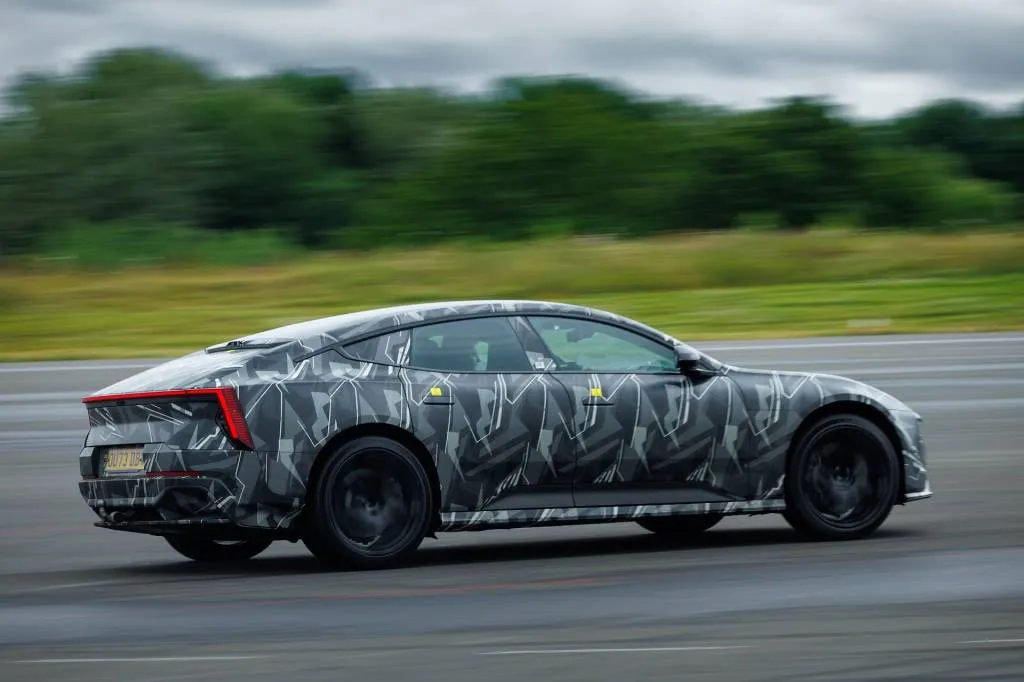Polestar’s Upcoming 5 Electric Sedan Targets the Elite EV Market
Polestar is gearing up to make waves with its forthcoming 5 electric sedan, setting its sights on competitors like the Tesla Model S and Lucid Air. Developed in the U.K., the Polestar 5 embodies advanced engineering, notably featuring a bonded-aluminum body similar to high-end models from Jaguar.
A Near-Complete Development
"We’re 80 percent done, but there’s more to do," stated Chris Baguley, Polestar’s principal engineer for vehicle dynamics, as he maneuvered a Polestar 5 prototype through a challenging cone setup at escalating speeds. Baguley spends considerable time tuning the suspension of the electric performance sedan to ensure it meets premium performance standards.
From the spacious rear seat, it seems nearly perfected, yet Baguley identifies a need for additional refinement. “The 2026 Polestar 5 is designed to understeer slightly when pushed to its limits," he explains. Despite the ongoing development, the vehicle’s rear tires screamed during tight turns, signaling its competitive edge in the high-performance EV arena.
On-Track Performance and Future Potential
When riding in the front seat, the vehicle’s understeer was more noticeable, thanks to its compact front suspension providing a sporty feel, complemented by a taller rear suspension enhancing passenger comfort. In a brief 20-minute spin, the Polestar 5 demonstrated potential to rival high-end electric sedans like the Lucid Air Sapphire and Porsche Taycan. However, its full capabilities will only become clear upon the production model’s release.
Expanding Polestar’s Portfolio
As the 2025 Polestar 3 SUV and the 2025 Polestar 4 coupe-crossover advance in production, Polestar can now outline its future plans. The Polestar 2 has significantly evolved since its 2021 introduction, gaining enhancements like a switch to rear-wheel drive for single-motor models. This evolution positions it strongly in the electric compact utility vehicle market.
Though the launch of Polestar 3 faced delays due to software issues, both the Polestar 3 and Polestar 4 are set to hit the market soon. This strategic expansion allowed Polestar to showcase its R&D prowess, highlighting its U.K. development team’s strength.
Developing the Polestar 5
Our visit to a testing facility outside Coventry, England, underscored Polestar’s commitment to engineering excellence. Here, the Polestar 5 is being fine-tuned on Polestar’s first dedicated architecture, distinct from the shared platforms of the Polestar 2, 3, and 4. CEO Thomas Ingenlath hinted that this unique structure might eventually serve other Geely and Volvo vehicles, underlining its technological significance.

Lightweight and Innovative
Polestar’s new U.K. R&D facilities house a significant advancement: a massive oven essential for curing the bonded-aluminum structure of the Polestar 5. Although specifics on the epoxy adhesive and curing temperatures are confidential, this process signifies a leap in automotive technology.
From Concept to Production
The journey from the Polestar Precept concept, unveiled in 2020, to the production-ready Polestar 5 involves rigorous development. A key design challenge was maintaining the concept’s low nose and cowl height, demanding a compact front suspension. This design choice aids aerodynamics and endows the Polestar 5 with a distinctive sports-sedan appearance, positioning it against models like the Porsche Panamera and Taycan, and the Tesla Model S.
The production for the 2026 Polestar 6 two-seat sports car will share the manufacturing facility in Chongqing, China. This strategic approach ensures a streamlined production process as new models emerge.
Market Position and Design Philosophy
Polestar is defining its brand with a mantra of "pure progressive performance," positioning the Polestar 5 as a European-style EV focusing on precise, controlled handling. In contrast to American styles like the Lucid Air, Polestar’s vehicles offer a distinctly European driving experience.
Despite its Swedish roots and European development, Polestar is diversifying global production due to geopolitical factors. The Polestar 4’s export production will shift to South Korea, mitigating trade tensions with key markets.
Building Brand Recognition
Polestar aims to gain traction in the U.S. with the introduction of the Polestar 3 SUV, which targets the premium segment of the SUV market. The Polestar 5, lacking a traditional rear window, innovates with rear-view cameras, promising a unique design that will test market preferences.
Conclusion
The Polestar 5 represents a significant milestone for the brand, showcasing a blend of cutting-edge technology and strategic market positioning. As the U.K. R&D facilities ramp up, anticipation builds for Polestar’s innovative electric vehicles. Keep an eye out for comprehensive reviews and firsthand experiences in real-world driving conditions as these models hit the market.
Steven Hale, Editor at Automotive.fyi
Twitter: @automotivefyi
Email: tips@automotive.fyi
Visit Automotive.fyi for all the latest news in automotive.


